Based on expert inputs from our 100+ Security Professionals we found Python to be the best programming language for Penetration Testing. Still, our experts at CyberSapiens emphasise that to fully utilize the power of Python, one must have a solid understanding of Python Language. Its advantages over other programming languages like versatility, cross-platform compatibility and ease of integrating it with other tools make it the first choice of many expert penetration testers.
Penetration testing, also known as pen testing or ethical hacking, is the practice of simulating a cyber attack against a computer system, network, or web application to test its defences and identify vulnerabilities. As a penetration tester, one of the most essential skills is proficiency in a programming language.
The right programming language can make all the difference in successfully identifying vulnerabilities, exploiting them, and reporting findings to clients. But with numerous programming languages available: which is the best programming language for penetration testing?
In this article let’s explore “Which is the Best Programming Language for Penetration Testing?“.
Top 4 Best Programming Language for Penetration Testing
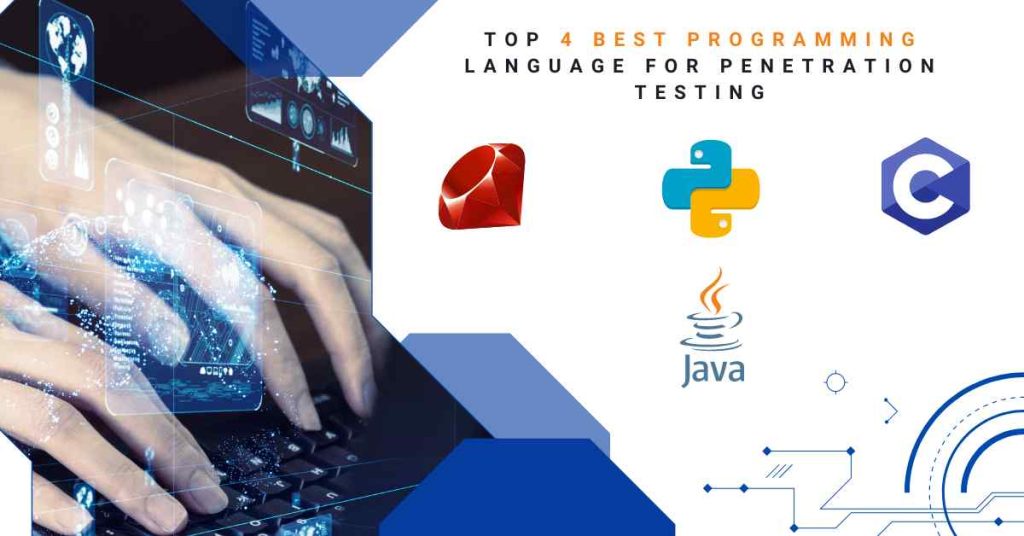
1. Python: The best programming language for Penetration Testing
Packed with various excellent features, Python is considered to be the best programming language among penetration testers. It is simple to use, suitable for almost any type of pen testing and has large libraries for both the tool and the website.
One of the biggest advantages of Python as a language is that it is easy to read, and hence, does not require much effort to understand the script, leaving the task for testers strictly technical.
Python’s popularity in pen testing stems from its ability to perform various tasks, including:
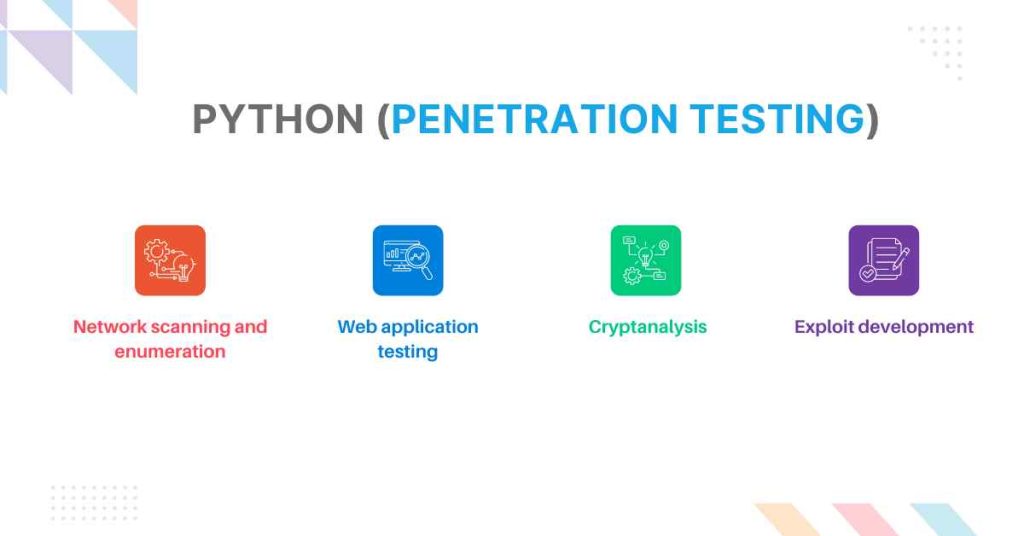
1. Network scanning and enumeration
Python’s scapy library is a powerful tool for packet sniffing, network discovery, and protocol analysis.
2. Web application testing
It review shows that Python’s requests can be used with ease in making HTTP requests and parsing HTML to determine pre-existing vulnerabilities in web applications.

3. Cryptanalysis
It is impossible to devise a comprehensive list of all the features offered by Python’s cryptography library; however, it should be pointed out that this tool offers some cryptographic algorithms for performing the operations associated with encryption, decryption, and cryptanalysis.
4. Exploit development
Pwntools for building exploits and reverse engineering binaries and much more, the Python language has many growths.
Python’s extensive libraries and modules, such as Nmap, sqlmap, and Metasploit, make it easy to integrate with other tools and frameworks, further increasing its utility in pen testing.
2. Ruby
Ruby is another popular programming language among penetration testers, particularly those who focus on web application security. Ruby’s syntax is similar to Python’s, making it easy to learn and use.
Ruby’s strength lies in its web application framework, Ruby on Rails, which provides a robust platform for building web applications and identifying vulnerabilities.
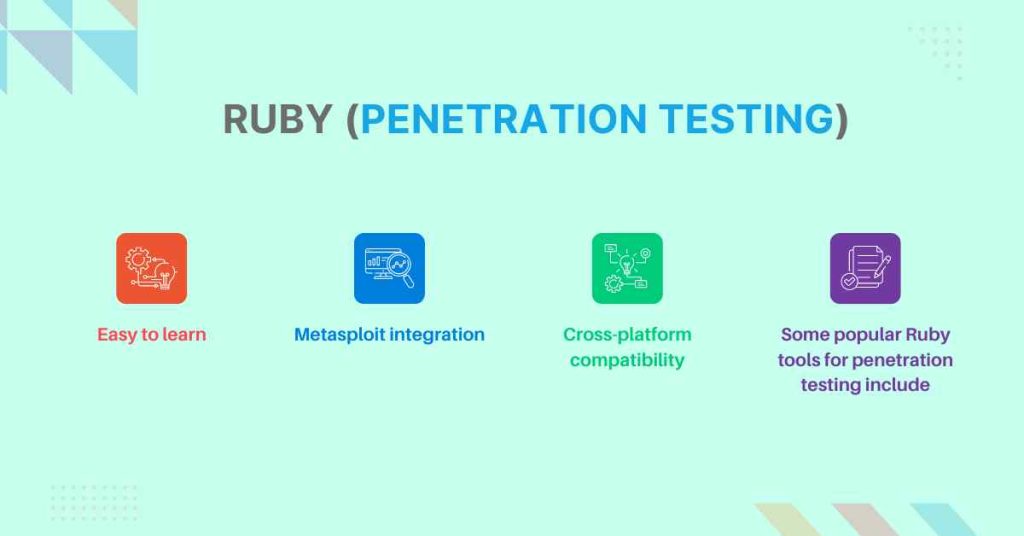
1. Easy to learn
Ruby has a simple syntax and is easy to learn, even for those with limited programming experience.
2. Metasploit integration
Ruby is used as the primary language for Metasploit, one of the most popular exploitation frameworks in penetration testing.
3. Cross-platform compatibility
Ruby can run on multiple platforms, including Windows, Linux, and macOS.
4. Some popular Ruby tools for penetration testing include
- Metasploit: An exploitation framework used to identify and exploit vulnerabilities.
- Armitage: A graphical interface for Metasploit that provides an easy-to-use interface for penetration testing.
3. C- Programming Language
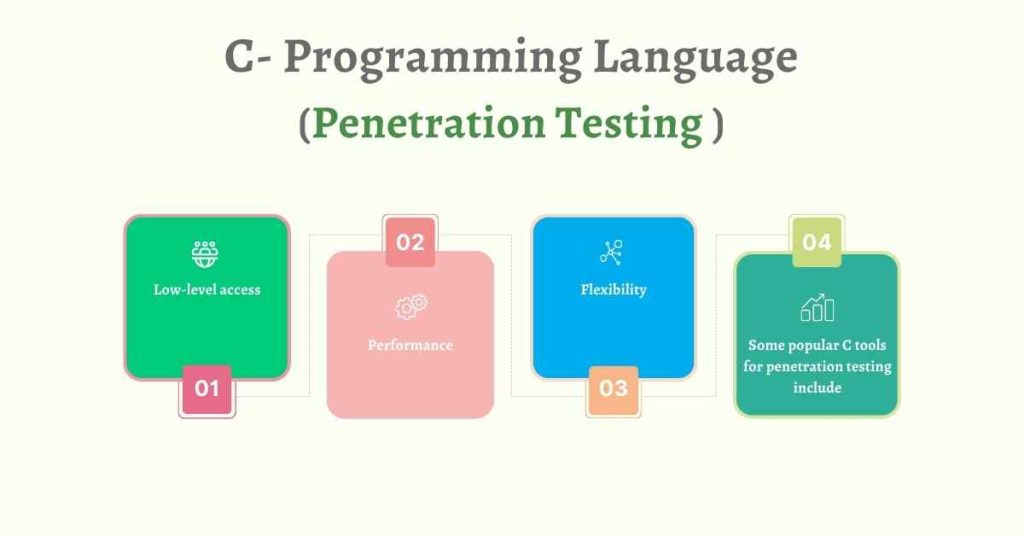
C is a low-level, general-purpose programming language that’s commonly used in penetration testing. It’s known for its performance, reliability, and flexibility, making it an ideal choice for developing custom exploits and tools. C’s strengths in penetration testing include:
1. Low-level access
C gives the programmer raw access to the hardware and system resources hence is suitable for creating customized exploits and tools.
2. Performance
C is much faster than Python and Ruby because it is a compiled language.
3. Flexibility
C can be used in many applications including the creation of operating systems as well as creating custom exploits.
4. Some popular C tools for penetration testing include
- Binutils: It is a group of binary tools employed in the analysis of executable files and their modification if necessary.
- GDB: A tool that is employed to help in the analysis and fixing of codes.
4. Java Programming language
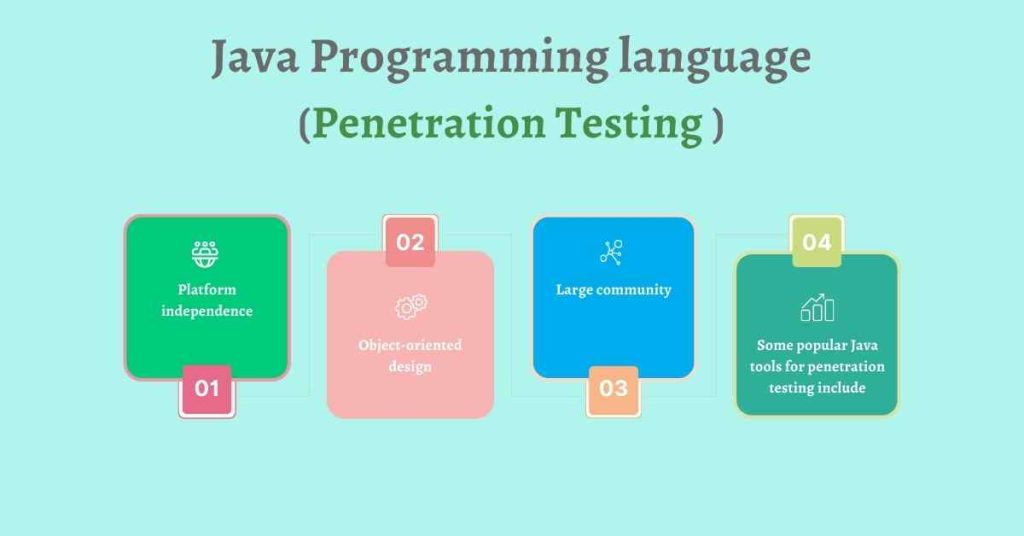
Java is an object-oriented programming language that’s commonly used in penetration testing. It’s known for its platform independence, making it an ideal choice for developing cross-platform tools and applications. Java’s strengths in penetration testing include:
1. Platform independence
Java can be used on any machine that has a JVM installed in it.
2. Object-oriented design
The object orientation of Java also makes the development of multi-tools and applications fairly flexible.
3. Large community
Java is a popular language that comes with a vast number of developers and users therefore, there is so much support.
4. Some popular Java tools for penetration testing include
- Burp Suite: Another tool popularly implemented in the testing of security in web applications which is used to detect any weakness in the web applications.
- Cobalt Strike: A penetration testing framework used to model the conceptual wheel of attack and subsequently hone the domes.
Why Programming Matters in Pentesting?

In the above topic, you have seen the top list of best programming languages for penetration testing. But do you know why this programming language matters in pen-testing? Don’t worry here is your answer.
Penetration testing goes beyond running pre-built scanners. It’s about understanding systems, exploiting vulnerabilities, and crafting creative solutions. Here’s how programming empowers pen testers:
1. Automation
Some of the routine activities such as data analysis, vulnerability scanning, and report generation can be done by scripts.
2. Customization
It can be argued that the existing tools may not always address all aspects. You can create your scripts to focus on specific weaknesses or include it with other programs for better performance.
3. Exploit Development
There are cases when you will face a vulnerability that needs to be attacked with a specific piece of code. This is because programming knowledge enables you to develop such tools and go deeper into the system.
4. Understanding Malware
Knowing how the malware is coded, for example in C or Assembly language will help in analyzing and identifying it.
Which Language is Best for Penetration Testing?
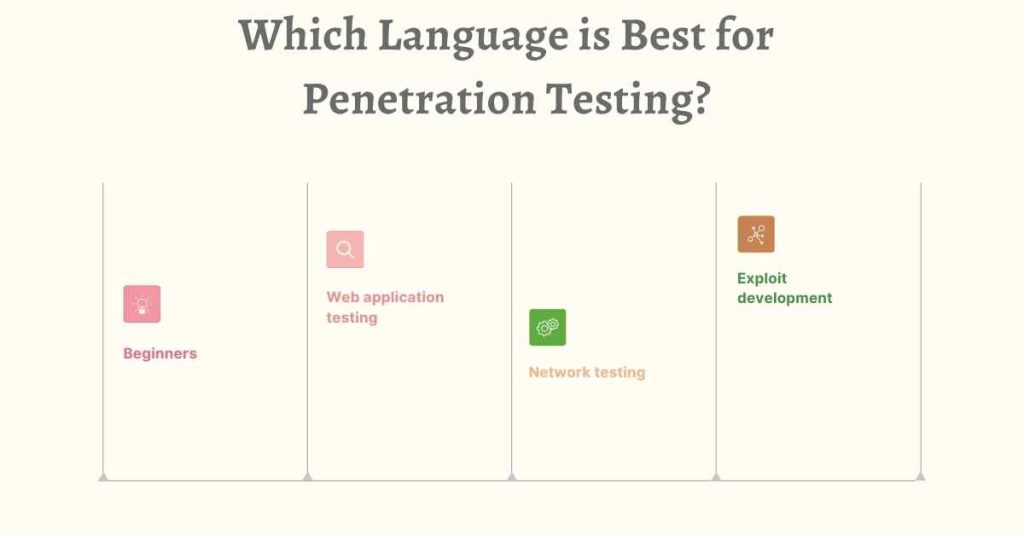
The answer to this question depends on the specific needs and goals of the penetration test. But among all the programming languages we considered Python as the best programming language
Here are some general guidelines you need to consider:
1. Beginners
Python is an ideal language for beginners due to its ease of use and extensive libraries.
2. Web application testing
Ruby, Python, and Java are all popular choices for web application testing due to their extensive libraries and tools.
3. Network testing
C and Python are popular choices for network testing due to their ability to interact with network protocols and systems.
4. Exploit development
C and Assembly are popular choices for exploit development due to their low-level access and performance.
Conclusion
In conclusion, each programming language has its strengths and weaknesses, and the best language for penetration testing depends on the specific needs and goals of the test. However, Python, Ruby, C, and Java are generally the most popular choices due to their versatility, ease of use, and extensive libraries.
FAQs: Which is the Best Programming Language for Penetration Testing?
1. Do I need to know programming to be a pentester?
Ans: While not strictly mandatory, programming skills are incredibly valuable for penetration testing. They empower you to automate tasks, create custom tools, and delve deeper into exploiting vulnerabilities.
2. What’s the single best programming language for pen testing?
Ans: There’s no single “best” language. Each has its strengths and weaknesses. Python is a great beginner choice, while Bash Scripting is essential for Linux users. More advanced testers might explore C++ for low-level tasks or Java for web application security.
3. Should I learn Python or Bash Scripting first?
Ans: For beginners, Python offers a gentler learning curve. However, basic Bash Scripting knowledge is crucial for navigating the Linux environment, commonly used in pen testing. You can learn both eventually!
4. I’m new to programming. Should I start with Python or learn Bash Scripting first?
Ans: This depends on your goals. For a well-rounded foundation, consider learning both eventually.
Python: Offers a gentler learning curve with a vast array of libraries specifically designed for penetration testing.
Bash Scripting: Essential for navigating the Linux environment, commonly used in pen testing. You can start with basic scripting commands and progress further as you gain experience.
5. Are there any certifications that value programming skills for pen testers?
Ans: Yes! Certifications like OSCP (Offensive Security Certified Professional) highly value scripting and automation skills using languages like Python and Bash.
6. What are some popular libraries for pen-testing in Python?
Ans: Libraries like Metasploit Framework, Scapy, and Paramiko offer powerful functionalities for various pen-testing tasks.
7. Can I use programming to bypass security tools?
Ans: Sometimes, custom scripts can help bypass basic security measures. However, remember that ethical hacking is about responsible testing, not malicious activities.
8. Is learning a compiled language like C++ necessary for pen testing?
Ans: Not necessarily for beginners. However, for advanced testers interested in exploit development or system programming, C/C++ offers fine-grained control and efficiency.
9. How can I practice my programming skills for pen testing?
Ans: There are online platforms with “capture the flag” (CTF) challenges that involve exploiting vulnerabilities using scripting languages. These are great for hands-on practice.
10. What are some resources to stay updated on new developments in programming languages for pen testing?
Ans: Follow blogs and communities focused on information security and penetration testing. Some conferences and workshops cover the latest trends in pen-testing tools and languages.












